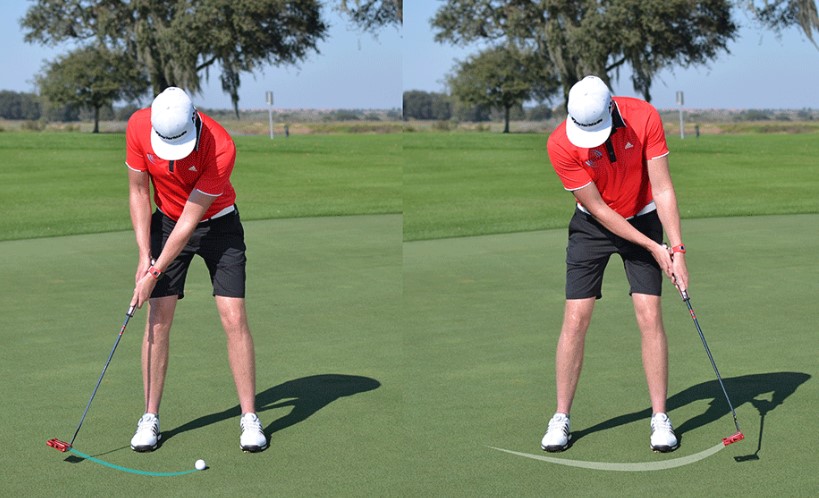In golf, there are three core shot types that all players must master: tee shots, approach shots, and putting. Among them, putting is often considered the most difficult—requiring intense concentration, patience, and refined technical skill. This shot is made using a special club called a putter, with the goal of rolling the ball into the hole on the smooth, subtly sloped surfaces of the green.
A common mistake among beginners is focusing first on full swings before addressing simpler shots like putting. In fact, the ideal training progression is the reverse—begin with mastering putting, then gradually work back toward long shots. The reason is simple: putting is the final act that often determines your score on each hole. Master it early, and you build a strong foundation for the rest of your game.
Statistics show that about 40% of all strokes during a round are putts. That means nearly half your score comes down to how well you can putt. If you master this skill, your chances of lowering your overall score increase dramatically. But if you neglect it, even perfect tee and approach shots can be undone by missed putts.
Lack of understanding in putting technique, combined with insufficient practice, often leads to inaccurate results. According to GoGolf, learning the secret strategies of putting and practicing them routinely is a crucial step for anyone who wants to win—whether playing recreationally or competitively.
Read the Green: The Foundation of Successful Putting
The first key to mastering putting is learning to read the green’s conditions. The green is the fine grass surface where the ball rolls into the hole. Its characteristics—rolling speed, surface slope, grain direction, and texture—can significantly influence the ball’s path.

Reading greens goes beyond picking a line to the hole. Experienced golfers consider:
- Surface slope and undulations
- Surrounding low areas or dips
- Grain (direction of grass growth)
- Weather, which can affect how fast the ball rolls
For example, a downhill green causes the ball to move faster; an uphill green slows it down, requiring more force.
Many beginners rely heavily on their caddy’s advice instead of developing their own instincts. However, building that self-reliance is important for confidence. Drill ideas include walking around the putting path, observing the slope, and seeing how a softly hit ball behaves under different green conditions.
Also pay attention to grass length: freshly mown greens allow faster rolls, while slightly longer grass slows the ball. In professional tournaments, green speed is measured with a Stimpmeter, giving a precise reading of how fast or slow the green plays.
Mastering green reading gives you a strategic edge. With accurate calculation, you can choose the right aim point and stroke strength, boosting your chances of hitting the hole in one or two putts.
Book your tee time easily with the GoGolf app—Download Now!
Visualize the Putting Line: Focus on the Process, Not Just the Hole
One secret to putting success is visualizing the ball’s path before you hit. Many beginners fixate on the hole itself—but what’s more important is understanding the line the ball must take to get there.
Begin by imagining the ideal trajectory, including the break caused by slopes. A helpful trick is to pick a small aim point just a few centimeters in front of the ball along that line. Focus your eyes on that point rather than the hole. This method helps your brain align hand-eye coordination more consistently.
Why is this effective? Hitting directly toward the hole without accounting for breaks often leads to misses—especially on uneven greens. Visualizing allows you to anticipate movement and compensate.
You can practice this with a string line or thin thread laid along your intended path. It helps you see how the ball reacts to the green and strengthens your projection skills.
Professional golfers like Jordan Spieth or Dustin Johnson follow disciplined visualization routines—they imagine not just the line, but also the speed of roll. The result: highly accurate putts, even under tournament pressure.
Executing the Perfect Put: Control, Consistency, Accuracy

Once you’ve read the green and visualized the line, it’s time to execute your putting technique. A common mistake is hitting the ball too hard or too soft, so it doesn’t reach the hole. Remember: putting isn’t about lofting the ball—it’s about rolling it with precise control.
A core principle: keep the forward and backstroke lengths balanced. This ensures the ball rolls at a stable speed with minimal spin, making it easier to control direction. For longer putts, you can increase the stroke length symmetrically while maintaining rhythm.
Three critical elements to master:
1. Putter Grip
Your grip should promote stability. Position both thumbs atop the grip aligned to the shaft. Some golfers (especially left-hand dominant players) press more firmly with one hand, while keeping the other lighter to allow direction control.
2. Putter Setup/Positioning
Position the putter head just in front of the ball, aligned to your target. Before your stroke, make light pendulum motions to reduce muscle tension. Keeping the putter head slightly off the turf (about 1 cm) helps minimize friction with the green.
3. Push, Don’t Hit
The ideal putting motion is a smooth push, not a strike like a chip. Avoid wrist flicking; let your palms and shoulder rotation gently guide the ball. This motion helps maintain line integrity without erratic minor deviations.
Consistent practice of these three aspects improves control, accuracy, and confidence on the green.
Practice Short and Long Putts: Build Accuracy in Every Situation
No matter how refined your technique, success in putting depends on consistent practice. Ideally, split your session between short putts (1–3 meters) and long putts (5+ meters). Short putts train your precision and focus, while long putts develop your sense of pace and roll speed.
Practice on different green conditions— fast, slow, flat, sloped—so you can adapt to any course. Many pros allocate 40–60% of their practice time to putting. A popular drill is the ladder drill: set balls at increasing distances from the hole, and try to make each one in sequence without missing. It builds consistency and confidence under pressure.
[ Follow our social media Account: GoGolf Instagram | GoGolf Facebook | GoGolf X ]











